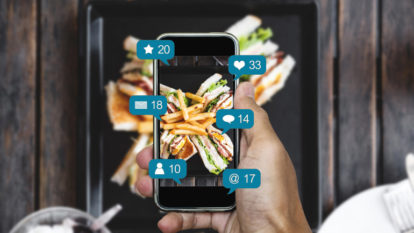It’s no secret that running a restaurant is hard work. However, a common misconception about the restaurant business is that you’ll open your doors and customers will just show up. Unfortunately, it takes more than having delicious dishes, great staff, and a memorable venue to get diners in the door and keep them coming back. That’s where having a restaurant marketing strategy comes into play.
A marketing strategy is a playbook for attracting and retaining customers. Keep reading to discover how to create one for your restaurant. You’ll learn:
- What a restaurant marketing strategy is
- Why you need a marketing strategy for restaurants
- How to create a restaurant marketing strategy
What Is a Restaurant Marketing Strategy?
A restaurant marketing strategy is a plan or a strategic roadmap for how you communicate with your target audience to promote your business. It’s essentially a guide for how to market a restaurant, written by you.
While this document can take any shape or form (e.g., slide deck, Google Doc, physical handbook, etc.), it should cover topics like business goals, metrics, high-level tactics you will use to achieve those outcomes, marketing resources, and guidelines for how you’ll measure success.

Get your free, step-by-step template to bring in new customers and keep them coming back.
Why You Need a Marketing Strategy for Your Restaurant
So, why should you take the time to create a marketing strategy for your restaurant? A marketing strategy for restaurants can help identify a number of things, including:
- How to market your restaurant.
- The market needs your restaurant meets and what gaps it fills.
- How your restaurant is different from the competition, which will inform all of your marketing initiatives.
- Who your restaurant is for – if you try to appeal to everyone, you’ll appeal to no one. Having a deep understanding of your customers will help you stand out.
- Which tools you need to run your business, such as a restaurant marketing platform like TouchBistro Marketing.
A strategy provides a cohesive plan so your whole team is on the same page and you can avoid any marketing catastrophes. For example, a marketing plan can inform your servers of which specials and promotions to share with customers. It also informs the person in charge of your restaurant’s social media what kind of content to post, such as featuring any upcoming restaurant partnerships.
Furthermore, a marketing plan helps your business meaningfully measure success by making you establish concrete goals. Without goals, it’s difficult to understand how well your restaurant is doing and what “well” actually means.
In addition to defining success, a marketing plan helps you achieve success. It gives you the blueprint for how to reach new customers, bring lapsed customers back, improve brand awareness, and more, based on your goals.

How to Create a Restaurant Marketing Strategy
Your restaurant’s marketing strategy should cover several key topics, including:
- Business goals
- Key metrics
- Restaurant marketing strategies
- Resources
- Measuring success
Here’s a closer look at what each of those sections should include.
1. Business Goals
Similar to a restaurant business plan, the first section of a marketing plan should be an introduction to your business and its goals. It can include things like your:
- Mission statement: A mission statement defines your restaurant’s purpose beyond simply feeding customers.
- Unique value proposition: This statement helps you establish what makes your business unique from all of the other restaurants out there.
- Target market: Who are your customers? Where do they live? What do they do? What are their dining habits like? What draws them to your restaurant?
Think of this section as a high-level summary of your business.
2. Key Metrics
Next, you need to describe how you will quantify and measure success. Your goals need to be SMART: specific, measurable, attainable, relevant, and time-bound.
A bad goal would be “we want to make more money.” Why? Because it’s too vague and isn’t time-bound. It also doesn’t describe how much more money you want the business to bring in.
A better example of a revenue-oriented goal is “we want to increase sales by 25% in Q2.” This goal is specific and measurable because it describes exactly how much you want to boost sales. Hopefully, you will have set that 25% goal based on patterns you’ve already seen in your revenue growth, so it’s a reasonable figure. The goal is relevant because the business is always generating revenue, and it’s time-bound because it specifies how long (three months) and by when (the end of June) you have to reach the goal.
Not sure what kinds of objectives to set? Consider these:
- Revenue targets (these can be as specific as different targets for different channels like dine-in, patio, or takeout, etc.)
- Website traffic
- Email sign-ups
- Loyalty program sign-ups
- Search engine rankings
- Social media audience growth
- Reservation volume

Get your free, step-by-step template to bring in new customers and keep them coming back.
3. Restaurant Marketing Strategies
Now it’s time to get to the good stuff: establishing the restaurant marketing strategies you’ll use to achieve the goals you’ve set. Split this section of your marketing plan up by channel, such as website and SEO, email marketing, social media, and in-app marketing.
Website and Search Optimization
Your website is your restaurant’s home on the internet and you’ll need to leverage different restaurant marketing ideas and tactics to boost web traffic.
Search engine optimization (SEO) is one of the most effective organic marketing strategies for a restaurant. SEO means optimizing your website so that it appears at the top of search engine (i.e. Google) results pages. Here are several SEO tips to get you started:
- Include your address on your website
- Optimize your contact page with your address and phone number
- Use keywords related to your location and cuisine on your website (e.g., “Italian food in Miami”)
- Leverage your blog (fresh blog content will help you rise up in the ranks)
- Claim and manage your Google My Business listing
- Ask customers for reviews and manage them effectively (e.g., remove Yelp spam comments)
Beyond SEO, it’s important to optimize your website for conversions. Do this by adding the following to your website:
- Sign-up button for your email list
- Call to action to order online
- Button to make a reservation
- Call to action to follow you on social media
Your website is one aspect of your marketing you have complete control over, so optimize your web presence before focusing on other marketing tactics.
Email Marketing
Email marketing is another one of your most important marketing channels. Why? Because its return on investment is difficult to beat. For every $1 spent on email marketing, you can expect to generate $36 in returns. And unlike social media, there are no algorithms that prevent your followers from seeing your content. If you have the right email address, subscribers will receive your emails.
There are a number of email marketing strategies for a restaurant to implement. We recommend starting with one-off emails and automated email campaigns, and then segmenting your campaigns to further personalize your communications.
One-Off Email Campaigns
One-off emails are sent ad hoc rather than as part of pre-planned, evergreen email campaigns. Use these emails to give subscribers the scoop on the latest dishes, events, and promotions at your restaurant. For instance, take a page out of Pilot Coffee Roaster’s book, one of many restaurant email examples, that launched an email to announce its promotion, giving away free drip or cold brew coffee for one day.
Avoid being spammy and limit these emails to up to two per week. A tool like TouchBistro Marketing can help you segment your audience to send the right message to the right people at the right time.
Automated Email Campaigns
TouchBistro Marketing can also help you create automated campaigns for your restaurant emails. For example, you can set up “we miss you” emails to customers you haven’t seen in a while, special birthday treat offers, and much more. With automated marketing campaigns, you can just set it and forget it, and watch the results come in.
Email Segmentation
Segmenting your email audience can help make your messages resonate with subscribers. If you use various products that are integrated with one another and your POS, you can use customer data to create campaigns that are specifically based on your guests’ habits and preferences. For instance, if you use TouchBistro Loyalty or TouchBistro Online Ordering alongside TouchBistro Marketing, you can set up segments of like-minded customers, such as those who regularly order takeout or those who have ordered your veggie burger, and then send them targeted emails that speak to their order history.
Then send personalized, targeted messages to those customers – either one-offs or automated campaigns. You could send takeout customers a special coupon to dine in to introduce a new revenue stream from an already loyal audience.

Social Media Marketing
Although algorithms limit who sees your content on social media, it’s still a marketing channel worth investing in. Think of restaurant social media as a branding tool, rather than a sales tool. It helps you stay atop customers’ minds. Follow these basic rules to get started on the right track:
- Have a presence where your customers are active. Your audience research will help you determine which platforms to use. For example, if you’re appealing to families in the suburbs, you should spend more time on Facebook, as this platform attracts an older audience. Check out our marketing plan for family restaurants for inspiration. If you run a fast food restaurant on a college campus, TikTok is probably your best bet, as its audience skews younger.
- Post updates regularly (about once a day) to stay top of mind.
- Optimize your bio with your restaurant’s location, hours, website, and a call to action.
- Use calls to action in your content whenever possible. For example, don’t just include a link to your online ordering menu on Instagram Stories. Tell followers to “click here” so they know exactly what action to take next.
- Share user-generated content for social proof (a phenomenon in which people copy the behavior of others).
Because we have no control over social media algorithms, it’s important to leverage your social channels to drive customers to channels that you do own, such as your loyalty program, online ordering page, or email newsletter sign-up page. Link to these platforms and use calls to action whenever possible to inspire action.
In-App Marketing
Creating an app for your restaurant is unattainable unless you’re McDonald’s, right? Wrong! With TouchBistro Marketing, you can easily and affordably set up a Customer Web App (CWA) that your customers can access from their phones or computer.
With a CWA, you can create in-app messaging campaigns to send customers the right messages at the right time. For example, you can alert them to limited-time promotions, like a two-for-one deal from 2 to 4 p.m. to drive instant sales. You could also announce new dishes, advertise events, and more.

Get your free, step-by-step template to bring in new customers and keep them coming back.
4. Resources
In this section of your restaurant’s marketing strategy, you need to list the tools you’ll need to execute your plan, the people who will be involved, and how much money you’ll invest in these resources.
Tools
Equip your restaurant with these essential marketing tools:
- Marketing automation software: A tool like TouchBistro Marketing helps you automate email campaigns, create a Customer Web App, access analytics, and much more.
- Social media accounts: Establish profiles on the social media platforms that your ideal customers spend the most time on. Opening accounts on Facebook, Twitter, Instagram, and TikTok is free, quick, and easy.
- Social media management tool: Manually sharing content to multiple social media platforms in the moment is time-consuming. Use a tool like Hootsuite or Later to schedule posts to various platforms and streamline social media management.
- SEO tools: Once you graduate beyond the basics of SEO, could consider investing in an SEO solution to help you understand your website’s performance. While Google My Business and Google Analytics can provide a lot of data for free, Ahrefs and Moz can give you a detailed look at the search keywords you’re ranking for and opportunities to beat the competition.
- Point of sale (POS) system: Your restaurant’s POS system is a treasure trove of marketing data. Make sure the other tools you use (like your marketing platform and loyalty tool) integrate with your POS to maximize its utility.
- Loyalty tool: Implement a restaurant loyalty program, like TouchBistro Loyalty, to double as a CRM and help you gather data about your customers, which you can use to supercharge your marketing tactics.
People
List who will be involved in your marketing efforts. Decide if you’ll hire in-house help or outsource certain tasks.
Having your existing staff double as in-house marketers might be the cheaper option, but they could be less knowledgeable than marketing experts. However, this option gives you flexibility and boots on the ground, which can help you create great content.
On the other hand, outsourcing your marketing help means you’ll be working with experts. However, you’ll likely spend more and they’ll be less flexible because they won’t always know what’s going on with your business.
Budget
Set aside a budget for tools, people, and services. The tools we listed can cost anywhere from free to several hundred dollars each per month. Costs for marketing staff and services vary greatly, so research costs in your area and set your budget accordingly.
5. Measuring Success
Remember those goals you set in the “key metrics” section of your restaurant’s marketing plan? Now’s the time to measure your success. Pull metrics from various sources, such as:
- TouchBistro Marketing: With this product, you’ll find stats on your email campaigns. You can monitor open and click-through rates to find the right message for future email campaigns. And you’ll also be able to track promotion redemptions to figure out what works and make more informed business decisions.
- POS: Here you can see how your marketing efforts affect sales.
- CRM: Monitor how customer behaviors have changed in your CRM or loyalty tool.
- Social media reporting: Understand audience engagement and conversions through social media analytics.

Get your free, step-by-step template to bring in new customers and keep them coming back.
Marketing is something restaurants need to do actively, not just when business is slow. By creating a restaurant marketing plan, you’re building a blueprint for promotional activities. What are you waiting for? Write your restaurant marketing strategy today.
Free social media templates for your restaurant
Sign up for our free weekly TouchBistro Newsletter







